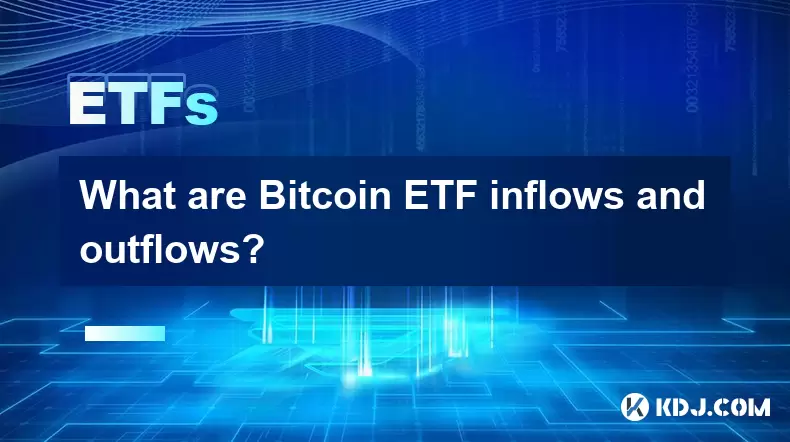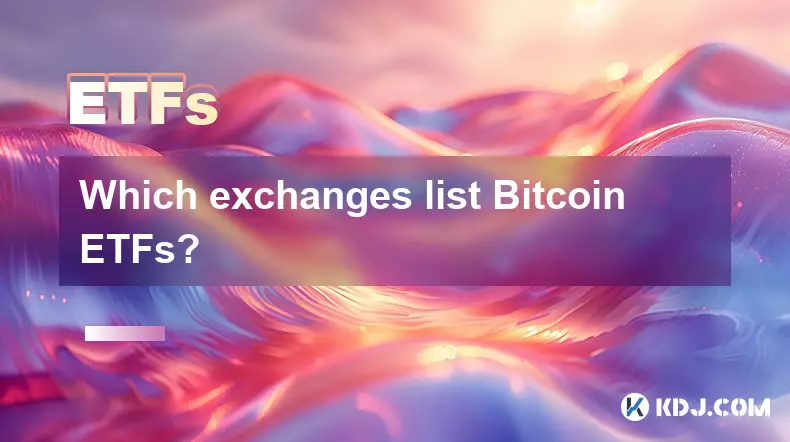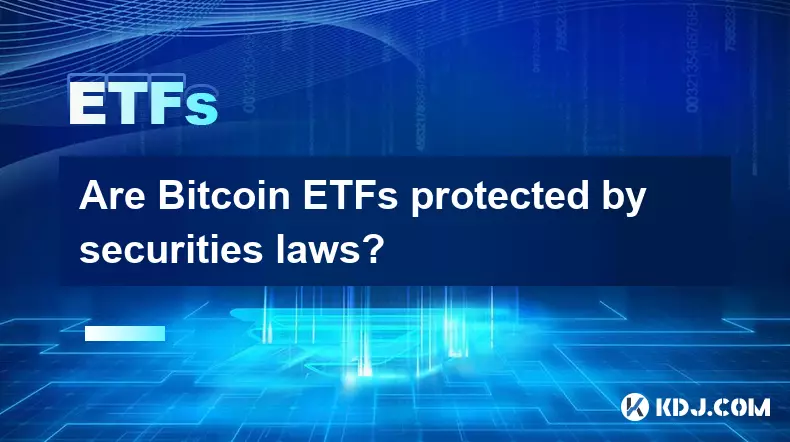-
 bitcoin
bitcoin $118548.520763 USD
3.67% -
 ethereum
ethereum $4352.564943 USD
4.79% -
 xrp
xrp $2.964058 USD
4.22% -
 tether
tether $1.000565 USD
0.05% -
 bnb
bnb $1028.372955 USD
1.46% -
 solana
solana $221.373507 USD
6.00% -
 usd-coin
usd-coin $0.999933 USD
0.02% -
 dogecoin
dogecoin $0.248633 USD
6.85% -
 tron
tron $0.341444 USD
2.38% -
 cardano
cardano $0.852946 USD
5.82% -
 hyperliquid
hyperliquid $47.869306 USD
6.15% -
 chainlink
chainlink $22.561476 USD
6.01% -
 ethena-usde
ethena-usde $1.001258 USD
0.05% -
 avalanche
avalanche $30.660000 USD
2.06% -
 stellar
stellar $0.400917 USD
9.76%
What are Bitcoin ETF inflows and outflows?
Bitcoin ETF inflows signal rising investor confidence as funds buy more Bitcoin, while outflows reflect reduced interest or profit-taking, impacting market sentiment.
Jul 21, 2025 at 12:35 pm

Understanding Bitcoin ETF Inflows
Bitcoin ETF inflows refer to the net amount of capital that flows into a Bitcoin Exchange-Traded Fund (ETF) over a specific period. These inflows typically occur when investors purchase shares of the ETF, prompting the fund provider to acquire additional Bitcoin on behalf of the investors. Each inflow represents an increase in institutional or retail interest in Bitcoin through regulated financial instruments.
Inflows are often tracked daily and can be used as an indicator of market sentiment. When there is a significant inflow, it may suggest growing confidence in Bitcoin's price appreciation or broader adoption. The mechanism behind inflows involves authorized participants creating new ETF shares by depositing cash or assets equivalent to Bitcoin's value.
- Investors buy ETF shares on the open market.
- The ETF issuer responds by purchasing more Bitcoin.
- This increases the total assets under management (AUM) of the ETF.
This process ensures that the ETF maintains its exposure to Bitcoin without directly requiring individual investors to hold or manage cryptocurrency.
Deciphering Bitcoin ETF Outflows
Conversely, Bitcoin ETF outflows represent the net amount of capital leaving a Bitcoin ETF. Outflows occur when investors sell their ETF shares, leading the fund to redeem those shares and reduce its Bitcoin holdings accordingly. This can signal declining investor confidence or profit-taking after a price rally.
Outflows are also closely monitored by analysts and traders to gauge shifts in market dynamics. A sustained period of outflows may indicate bearish sentiment or macroeconomic concerns affecting risk assets like cryptocurrencies.
- ETF shareholders decide to sell their holdings.
- The ETF issuer sells Bitcoin to settle redemptions.
- This results in a decrease in AUM and potentially downward pressure on Bitcoin prices.
It’s important to note that while inflows and outflows impact ETFs, they do not directly affect Bitcoin's price but rather reflect investor behavior and expectations.
Difference Between Inflows and Outflows in Bitcoin ETFs
While both inflows and outflows relate to capital movement within Bitcoin ETFs, they have distinct implications. Inflows imply accumulation and optimism, whereas outflows suggest distribution and caution.
One key distinction lies in how these movements influence the supply and demand dynamics of Bitcoin indirectly. Inflows usually correlate with increased buying pressure on Bitcoin exchanges as ETF providers acquire more coins, while outflows can lead to selling pressure when ETFs liquidate holdings to meet redemption requests.
Another difference is in timing and volume. Large inflows during periods of rising prices can reinforce bullish trends, while sudden outflows amid volatility might exacerbate declines. Understanding this contrast helps investors interpret short-term market behavior influenced by institutional flows.
How Are Bitcoin ETF Inflows and Outflows Measured?
Measuring Bitcoin ETF inflows and outflows involves tracking daily changes in the fund’s net asset value (NAV) and share issuance or redemption activity. Data providers such as Bloomberg or CoinShares publish daily reports showing net inflows or outflows for major Bitcoin ETFs.
The calculation is relatively straightforward:
- Compare the previous day’s AUM with the current day’s AUM.
- Adjust for any price changes in Bitcoin.
- The remaining difference reflects net capital flow into or out of the ETF.
These figures are critical for understanding real-time investor behavior without needing direct access to exchange data. Additionally, many platforms offer visual dashboards that aggregate inflow and outflow data across multiple ETFs for comprehensive analysis.
Impact of Bitcoin ETF Inflows and Outflows on Market Sentiment
Market sentiment around Bitcoin is heavily influenced by ETF flows due to their institutional nature. Positive inflows are often interpreted as endorsements from professional investors who believe in Bitcoin’s long-term value.
On the other hand, consistent outflows may trigger concern among retail investors and traders. When large funds experience significant redemptions, it can signal uncertainty or fear in the broader crypto market.
Moreover, media coverage of substantial inflows or outflows can amplify emotional responses. For example, a record inflow following a regulatory approval could drive FOMO (fear of missing out), while unexpected outflows post a market dip might fuel panic selling.
Analyzing these patterns allows traders to anticipate potential price movements based on institutional participation rather than just speculative retail activity.
Frequently Asked Questions
What does a negative Bitcoin ETF inflow mean?A negative inflow indicates that more capital is exiting the ETF than entering it, which is referred to as an outflow. This suggests that investors are reducing their exposure to Bitcoin via ETFs, possibly due to market uncertainty or profit-taking.
Can Bitcoin ETF inflows predict price movements?While inflows don't guarantee price direction, they can serve as a proxy for investor sentiment. Sustained inflows may precede upward price trends, while persistent outflows could foreshadow corrections or consolidation phases.
Are Bitcoin ETF inflows taxable events?No, simply investing in a Bitcoin ETF does not trigger taxable events unless you sell your ETF shares at a gain. Taxation depends on your jurisdiction and whether you realize profits upon disposal of the ETF units.
Do all Bitcoin ETFs report inflows and outflows publicly?Most regulated Bitcoin ETFs disclose daily inflow and outflow data through official channels or third-party financial platforms. However, transparency levels can vary depending on the fund provider and regulatory requirements in the ETF’s domicile.
Disclaimer:info@kdj.com
The information provided is not trading advice. kdj.com does not assume any responsibility for any investments made based on the information provided in this article. Cryptocurrencies are highly volatile and it is highly recommended that you invest with caution after thorough research!
If you believe that the content used on this website infringes your copyright, please contact us immediately (info@kdj.com) and we will delete it promptly.
- BlockDAG, DOGE, HYPE Sponsorship: Crypto Trends Shaping 2025
- 2025-10-01 00:25:13
- Deutsche Börse and Circle: A StableCoin Adoption Powerhouse in Europe
- 2025-10-01 00:25:13
- BlockDAG's Presale Buzz: Is It the Crypto to Watch in October 2025?
- 2025-10-01 00:30:13
- Bitcoin, Crypto, and IQ: When Genius Meets Digital Gold?
- 2025-10-01 00:30:13
- Stablecoins, American Innovation, and Wallet Tokens: The Next Frontier
- 2025-10-01 00:35:12
- NBU, Coins, and Crypto in Ukraine: A New Yorker's Take
- 2025-10-01 00:45:14
Related knowledge

Will Bitcoin ETFs affect Bitcoin's decentralized nature?
Sep 24,2025 at 02:00am
Impact of Bitcoin ETFs on Market Accessibility1. Bitcoin ETFs have significantly lowered the barrier to entry for traditional investors who may not be...

How do arbitrage opportunities exist with Bitcoin ETFs?
Sep 30,2025 at 12:36am
Understanding Bitcoin ETF Arbitrage Mechanics1. Bitcoin ETFs trade on traditional stock exchanges, allowing investors to gain exposure to Bitcoin pric...

Which exchanges list Bitcoin ETFs?
Sep 26,2025 at 03:18am
Major Cryptocurrency Exchanges Offering Bitcoin ETFs1. The landscape of digital asset trading has evolved significantly with the introduction of Bitco...

Are Bitcoin ETFs protected by securities laws?
Sep 28,2025 at 03:00am
Regulatory Framework Surrounding Bitcoin ETFs1. Bitcoin ETFs operate within the boundaries of established securities regulations, primarily under the ...

What role does a Bitcoin ETF play in an investment portfolio?
Sep 27,2025 at 12:36am
Understanding the Function of a Bitcoin ETF in Portfolio Diversification1. A Bitcoin ETF allows traditional investors to gain exposure to cryptocurren...

Is the volatility of Bitcoin ETFs consistent with Bitcoin?
Sep 26,2025 at 01:18am
Bitcoin ETFs and Their Relationship to Bitcoin Price Movements1. Bitcoin ETFs are financial instruments designed to mirror the price of Bitcoin withou...

Will Bitcoin ETFs affect Bitcoin's decentralized nature?
Sep 24,2025 at 02:00am
Impact of Bitcoin ETFs on Market Accessibility1. Bitcoin ETFs have significantly lowered the barrier to entry for traditional investors who may not be...

How do arbitrage opportunities exist with Bitcoin ETFs?
Sep 30,2025 at 12:36am
Understanding Bitcoin ETF Arbitrage Mechanics1. Bitcoin ETFs trade on traditional stock exchanges, allowing investors to gain exposure to Bitcoin pric...

Which exchanges list Bitcoin ETFs?
Sep 26,2025 at 03:18am
Major Cryptocurrency Exchanges Offering Bitcoin ETFs1. The landscape of digital asset trading has evolved significantly with the introduction of Bitco...

Are Bitcoin ETFs protected by securities laws?
Sep 28,2025 at 03:00am
Regulatory Framework Surrounding Bitcoin ETFs1. Bitcoin ETFs operate within the boundaries of established securities regulations, primarily under the ...

What role does a Bitcoin ETF play in an investment portfolio?
Sep 27,2025 at 12:36am
Understanding the Function of a Bitcoin ETF in Portfolio Diversification1. A Bitcoin ETF allows traditional investors to gain exposure to cryptocurren...

Is the volatility of Bitcoin ETFs consistent with Bitcoin?
Sep 26,2025 at 01:18am
Bitcoin ETFs and Their Relationship to Bitcoin Price Movements1. Bitcoin ETFs are financial instruments designed to mirror the price of Bitcoin withou...
See all articles










































































